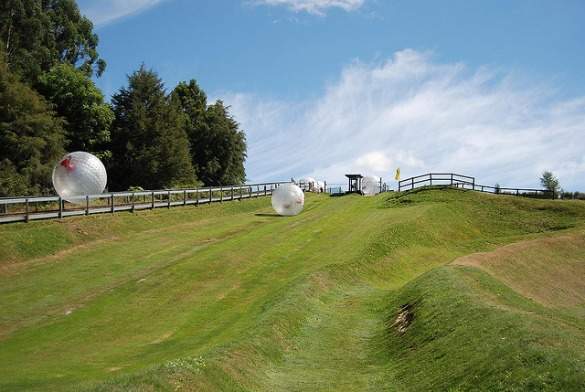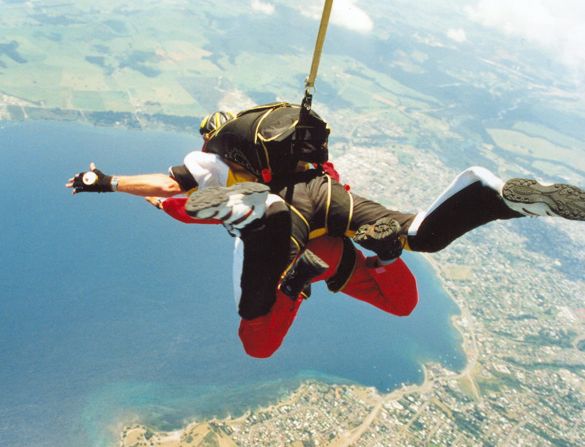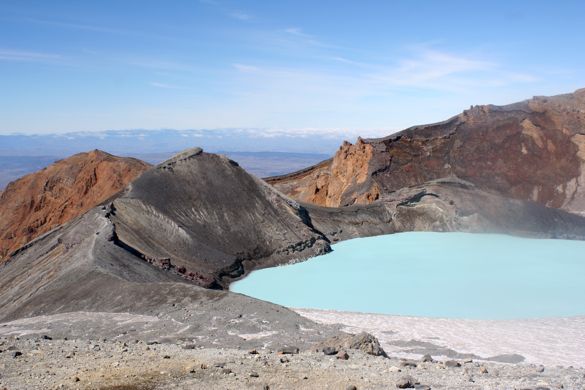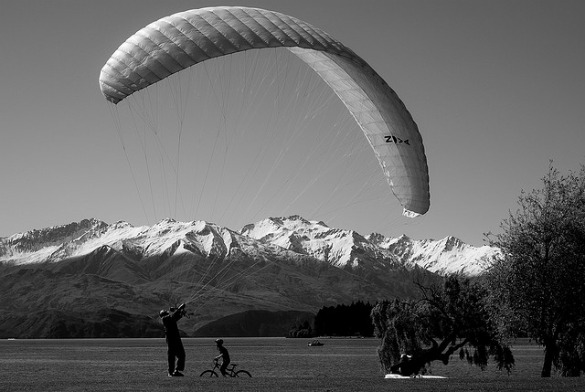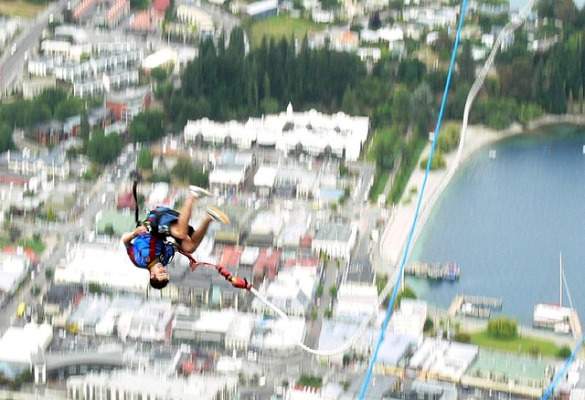Isaac Newton said it best: what goes up must come down. On a trip to New Zealand, there is much that will fall under the first half of his statement. The country’s natural scenery will have your spirits soaring and your new-found addiction to adventure activities will send an unheard-of amount of adrenaline pumping through your veins. So if Newton was right and you’re left with no choice but to make an inevitable return to reality, make sure you do it in style.
To help you do so, here are the top eight ways to go downhill in New Zealand, from skydiving to sandboarding to sliding down volcanoes. They’re even set up north to south—beginning at the tip-top of Cape Reinga and ending up at the bottom of the South Island—so your very journey around the country will be a downhill race to the bottom. Just make sure to hold on tight!
Sandboarding in Cape Reinga
If you’ve ever been boogie boarding at the beach, you’ll be familiar with how to hold the board—hands tight, chest balanced, the hard foam steady and straight beneath you. Now, take away the waves, substitute a sand dune, and you’ll soon be sandboarding down the Te Paki dunes just south of Cape Reinga. However strange it sounds, it’s a staple activity on many of the day trips to the far north of New Zealand.
Bus tours might not always be your first choice as a traveler, but when it comes to getting to and around Cape Reinga, many times they’re the only option—especially if you’re hoping to drive down Ninety Mile Beach. All of the main tours that pick up from Paihia and other cities in the Bay of Islands—from the Dune Rider to NakedBus’ Off Road Safari—usually include stopping off at this huge section of sand dunes along the way to the cape.
Zorbing in Rotorua
Rotorua isn’t known as Roto-Vegas for nothing. From the moment you arrive in the sulfur-filled town halfway between the Coromandel Peninsula and Lake Taupo, it’s easy to feel overwhelmed by choices—and the fact that nearly everything seems to have an admission price. But if you’re short on time (and cash), go past the hot springs and mud pools, the manicured English gardens and Maori culture, and head straight to the Zorb headquarters.
Defined by Wikipedia as “the recreation of rolling downhill in an orb,” there are two options when it comes to Zorbing. The first is a dry “Zorbit” run whereby the “zorbonaut” is strapped inside the giant plastic ball in a harness not unlike that found on a roller-coaster. The second, known as the Zydro ride—or “hydro-zorbing”—involves donning swimsuits, waiting as attendants fill the inside of the orb with a few inches of water, and then diving in through a small opening before being pushed down the hill. Thirty seconds later, you’ll emerge a little wetter, a whole lot dizzier, and no doubt racing to do it again.
>> Read about other crazy adventure sports and where you can do them
Skydiving over Lake Taupo
Many people have pointed out that the shape of Lake Taupo resembles a heart, a fitting comparison given its location at the center of the North Island. It’s also the biggest lake in all of Australasia—with a surface area of 238 square miles, it’s even the same size as the main island of Singapore. Be it trout fishing, jet boating, or mountain biking, there’s no end to the number of adventure activities available around Lake Taupo, but perhaps the best way to truly take in the region’s beauty is from above—15,000 feet above it, to be precise.
Tandem skydiving companies abound in Taupo – Taupo Tandem Skydiving and Skydive Taupo are a couple from which you can choose. Before taking to the skies, though, you’ll be strapped into a harness and then attached to your jumpmaster by a number of strong points. By the time you’re in the air, you’ll be too distracted by the volcanic landscape below to remember what exactly you’re doing up there in the first place.
>> Discover seven stunning lakes of the South Island of New Zealand
Sliding down scree on Mount Ruapehu
The one-day Tongariro Alpine Crossing is definitely the star of the show when it comes to hiking through the central plateau of the North Island, but not far from the crossing looms Mount Ruapehu, Maori for “pit of noise” or “exploding pit.” The name is apt, given it is the largest active volcano in the country—and one of the most active in the world. Even so, guided hikes are available to take you up the mountain and around the crater lakes, giving you the perfect vista of the lunar landscape stretching out below.
The hike begins with a chair-lift ride to 2,020 meters, and from there leads to a summit of 2,670m, from where you can even see Mount Taranaki in New Plymouth. The way around the rim of the crater passes an opaque ice blue lake and edges along narrow paths often pummeled by strong winds, but the highlight is learning to skip down the scree, a mix of loose gravel and ash, by keeping your knees high and sliding into your heels—which won’t feel too unlike doing a jig.
>> Learn about 11 famous volcanoes you can climb
Hiking down Franz Josef Glacier
As you leave the north behind and catch a ferry across Cook Strait, it’s the west coast of the South Island that holds the mystery of how a 12-kilometer glacier can exist so close to not only a rainforest, but to an ocean as well. But then again, co-existing microclimates seem to be one of New Zealand’s specialties. The two main glaciers in the region, Franz Josef and Fox, offer both half-day and full-day hikes, but only the second option gives a true taste of the glacial terrain past the terminal face.
Strap on crampons and grab an ice pick as one of your Franz Josef Glacier Guides leads you through narrow crevasses, naturally formed caves, and down steep stairs built into the ice. Although the steps are part of pre-formed tracks, the guides pause often to shape the ice with the large picks they carry. The hikes now even include a visit to the Glacier Hot Pools, the perfect way to thaw out after your day on the ice.
Snowboarding the Southern Alps
The Southern Hemisphere’s answer to the European Alps, with their pristine peaks and glassy finger lakes, are not meant to be seen from afar. Step into a snowboard and hit the slopes at over twenty different ski resorts located on the South Island. Although Hamner Springs and Mount Hutt are each only an hour or two from Christchurch, Queenstown is the most popular place to base yourself for the ski season, giving you access to four ski fields—and not to mention the nightlife!
From the shores of Lake Wakatipu in Queenstown, the Remarkables (“Remarks” in local lingo) and Coronet Peak are each an easy bus ride away, whereas Cardrona and Treble Cone are both closer to Wanaka and will be more of a day trip. If the idea of going off-piste is appealing, heliskiing/boarding can push you even further. Helicopters await to take you far from the crowded slopes of the ski fields to fresh, untouched powder where the only tracks will be your own.
>> Read about ski seasons around the world so you can hit the slopes all year round
Paragliding in Wanaka
If the frenetic, non-stop pace of Queenstown isn’t quite your style, escape to its sister city of Wanaka, just an hour away over the Crown Range Highway. Although half the size in terms of population, Wanaka is similarly set among the Alps on the edge of a narrow yet dramatic lake. You’ll find many of the same adventure activities on offering, but only Wanaka is home to the country’s highest tandem paragliding flight.
After being picked up by Wanaka Paragliding and taken to the top of a mountain, all you need is a gentle running start to soar above the valley below. As you coast through the air for nearly twenty minutes, you’ll pass waterfalls, enjoy views of the snow-capped peaks, and have the chance to complete a spiral landing. If you time it right, you could even make the annual paragliding festival in Wanaka, usually held during the first week of January.
Bungy jumping in Queenstown
If New Zealand is truly the center of the adventure world, then Queenstown is its capital. There’s no better way to end an adventure tour around New Zealand than with what is arguably the country’s most famous adrenaline-inducing activity: bungy jumping. Credited with inventing the first commercial bungy jump in the late 1980s, A.J. Hackett now offers three different bungys in Queenstown—the only question that remains is which one you’ll be able to handle.
Superlatives aren’t always necessary in travel description, but when it comes to bungy jumps, every meter of height counts. Next to the Bloukrans Bridge bungy in South Africa—which measures a breezy 216 meters—the Nevis Bungy in Queenstown is the second highest in the Southern Hemisphere and the highest in New Zealand. With its glass-bottomed Bungy Pod suspended at 134 meters over a dusty canyon and river, the jump offers 8.5 seconds of free fall—more than enough time to look back on the many downhill adventures you’ve had across the country…and then think about where you’re heading next.
>> Check out 14 extreme travel activities to get your heart pumping
Ready to go? Search for cheap flights to New Zealand, look for New Zealand adventure tours, and plan your trip with our New Zealand Travel Guide.
Photos by: 2 – murdocke23, 3 – TheCreativePenn, 5 – Velvet Android, 6 – AWWS, 7 – Daniele Sartori, 8 –Kinho Pizzato, all others courtesy of the author and may not be used without permission

